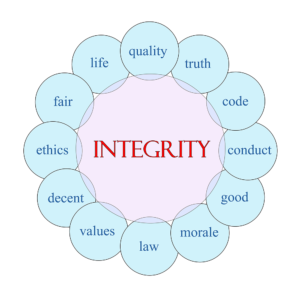Assessing Your Core Values: Recognizing Values and Needs
Recognizing Values and Needs
 Have you ever considered what makes you consistently yourself?
Have you ever considered what makes you consistently yourself?
Values generally remain relatively stable over time. They are difficult to change and usually arouse strong feelings not readily amenable to situational fluctuation or change. Despite changes in you and the conditions of your life, your values have remained relatively stable over time. At times, you may have noticed that your feelings have changed about specific issues or about certain people; these changes in your emotions were likely triggered by the behaviors of the other individuals involved or by the circumstances about which you were concerned, were in conflict with or that deviated from their original position. Your values have probably, thus, been responsible for changing your feelings.
There are numerous ways of assessing values and illustrating how widely individuals vary in their perceptions of situations and other people based on their values. Values may be classified broadly into aesthetic, political, economic, social, religious, and theoretical. As you think about yourself and your life in terms of these six classifications, you may be somewhat surprised to note that the values that stand out may be contrary to what you originally and impulsively would have predicted. Often, when you examine the essential underpinnings and motivating forces in your life, you’ll find that you have been acting in ways that do not direct you toward your goals most efficiently.
In addition, you might be surprised to learn that although you may appear to be behaving in the same way as someone else, you may be doing so based on different values. An example will illustrate: Chad works long hours as president of his own company. He gets to his office at about 8 a.m. and often stays until 9 or 10 p.m., working on reports or meeting with clients. Chad works hard, and in talking to him, one senses that Chad wants his company to be the top company in its field. When he retires, he wants to be a success and a multimillionaire. For him, work is a game; it is the most essential part of his life, and he would work round-the-clock if he could earn more money for his company.
Don, on the other hand, is also president of his own company and works from 8 a.m. until 9 or 10 p.m. Don works hard and wants his company to be successful; his success is motivated by his desire to be involved in the contacts and political power that he can gain through the success of his business. He has been working hard because he wants to be active politically and use his reputation to gain political power. Don sees his work as a means to an end in terms of achieving power rather than money.
These two men work hard and probably live similarly; they are both high-powered, highly motivated, and highly successful. Because their values differ, they base their actions on additional considerations and alternatives.
In assessing yourself, you need to determine the underlying motivations of your behaviors. If you respond based on your needs, you react differently than if you respond based on your values. Because of differences in needs and values, you must understand your own values to deal with your partner in terms that are acceptable to both of you.
In a relationship where value differences exist, the partners often respond to their differences in ways that indicate that they have not accurately assessed their underlying conflict. Consequently, they attempt to change the other person. When they encounter resistance, as they undoubtedly will, they respond pretty negatively and in ways that are hurtful to the other person. Such responses hurt the relationship as well.
A crucial assumption in maintaining healthy and well-functioning relationships is that the participants sometimes have different values and feelings about things. Part of the foundation of any relationship includes the other person’s right to be unique and to maintain their individual point of view. This acceptance of the other’s individuality is, in fact, acceptance of their right to function autonomously in the world apart from the relationship. To attempt to change this individual’s position, at times, is to impinge on their right to be themselves.
Many years ago, Dr. Thomas Gordon identified a method of differentiating between need and value conflicts. His work remains valid and valuable. According to Dr. Gordon, a need conflict carries a concrete and tangible effect on the other person. Thus, if in assessing a situation, you can tell the other person how their behavior has a tangible and concrete impact on you, then you are describing how their behavior relates to your getting your needs met. If, on the other hand, the other person’s behavior does not have a tangible and concrete effect on you, then your needs are not affected, but you have a conflict of values.
Checking for a concrete and tangible effect on the other person is a simple litmus test that works very well to differentiate values from needs. This assessment and evaluation of values vs. needs is critical in understanding how you might best proceed in your relationship.
In relating this understanding to your situation, it might be helpful to you to list the major issues that confront you in your relationship. Then, identify the behavior of the other person to which you react, determine your feelings in response to that behavior, and consider the effects of that behavior on you. If the effects are tangible and concrete, you can let your partner know how you feel; if the effects are not tangible or concrete, you will learn something about your differences in values and can also let your partner know. However, defining whether the conflict has to do with needs or values will give you realistic expectations of the kinds of change you can anticipate your partner to make.
It is hard to get another person to change their values when feelings are equally important to both of you. Understanding and accepting this fact is essential for a healthy relationship. It can reduce the friction that builds when the non-acceptance of the other person is based on existing values.
Note: This document was first published in Marriage in Trouble: A Time of Decision (Haspel, 1976).
References
Haspel-Portner, Eleanor. (1976). Marriage in trouble: a time of decision. Chicago, IL: Nelson-Hall.
Gordon, Thomas. (1970, 1975) P.E.T. Parent effectiveness training: the tested new way to raise responsible children. New York, NY: Peter H. Wyden, Inc.
